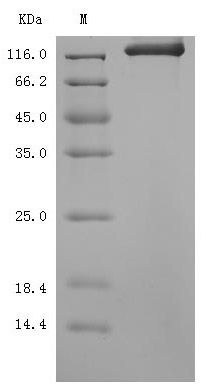The recombinant mouse semaphorin-4D (Sema4d) production involves gene cloning, plasmid preparation, protein expression, purification, and analysis. Primers are designed to amplify the gene encoding the 24-733 amino acid (aa) region of the mouse Sema4d protein, which is then cloned into a plasmid alongside the C-terminal mFc-tag gene. The recombinant plasmid is transfected into mammalian cells using a transfection reagent, and 24 hours later, a selective antibiotic is introduced to identify cells expressing the Sema4d protein. The cells are lysed to release the TNFSF15 protein, which is purified from the culture supernatant via affinity chromatography. SDS-PAGE confirms the recombinant Sema4d protein purity exceeds 95%. The endotoxin levels of the Sema4d protein are below 1.0 EU/μg, as measured by the LAL method. Functional ELISA demonstrates Pepinemab binding to the mouse Sema4d protein, with an EC50 ranging from 4.878 to 7.446 ng/mL.
Mouse Sema4D, also known as CD100, is a member of the semaphorin family of proteins, which are primarily recognized for their roles in axon guidance during neuronal development. Sema4D is expressed in various tissues, including the brain, heart, and immune cells [1][2][3]. It is mainly involved in the immune regulation, neurodevelopment, and angiogenesis.
Sema4D interacts with its receptor, Plexin-B1, which mediates several signaling pathways that influence cell migration, adhesion, and survival [4][5]. The binding of Sema4D to Plexin-B1 has been shown to activate intracellular signaling cascades, including the PI3K pathway, which is crucial for endothelial cell migration and angiogenesis [4][6]. This pro-angiogenic effect is particularly significant in the context of tumor biology, where Sema4D has been implicated in promoting tumor growth and metastasis through its effects on the vascular system [7][8].
Sema4D plays a role in neuronal axonal guidance and synaptic formation. It also regulates neuron-glial cell interactions. Sema4D has been identified as a key player in modulating T-cell responses and has been shown to influence the maturation of dendritic cells [9][10]. The immunoregulatory functions of Sema4D are particularly relevant in the context of autoimmune diseases, where its expression can affect the activation and differentiation of immune cells [11][12]. Studies have demonstrated that Sema4D-deficient mice exhibit resistance to experimental autoimmune encephalomyelitis, highlighting its role in T-cell-mediated immune responses [11].
References:
[1] A. Regev, S. Goldman, & E. Shalev. Semaphorin-4d (sema-4d), the plexin-b1 ligand, is involved in mouse ovary follicular development, Reproductive Biology and Endocrinology, vol. 5, no. 1, 2007. https://doi.org/10.1186/1477-7827-5-12
[2] S. Jhaisha. Soluble semaphorin 4d serum concentrations are elevated in critically ill patients with liver cirrhosis and correlate with aminotransferases, Diagnostics, vol. 14, no. 4, p. 370, 2024. https://doi.org/10.3390/diagnostics14040370
[3] M. Rezaeepoor, G. Rashidi, M. Pourjafar, C. Mohammadi, G. Solgi, & R. Najafi. Sema4d knockdown attenuates β-catenin-dependent tumor progression in colorectal cancer, Biomed Research International, vol. 2021, p. 1-12, 2021. https://doi.org/10.1155/2021/8507373
[4] J. Basile, T. Afkhami, & J. Gutkind. Semaphorin 4d/plexin-b1 induces endothelial cell migration through the activation of pyk2, src, and the phosphatidylinositol 3-kinase–akt pathway, Molecular and Cellular Biology, vol. 25, no. 16, p. 6889-6898, 2005. https://doi.org/10.1128/mcb.25.16.6889-6898.2005
[5] J. Soong, Y. Chen, E. Shustef, & G. Scott. Sema4d, the ligand for plexin b1, suppresses c-met activation and migration and promotes melanocyte survival and growth, Journal of Investigative Dermatology, vol. 132, no. 4, p. 1230-1238, 2012. https://doi.org/10.1038/jid.2011.414
[6] H. Zhou, Y. Yang, & J. Basile. Characterization of the effects of semaphorin 4d signaling on angiogenesis,, p. 429-441, 2016. https://doi.org/10.1007/978-1-4939-6448-2_31
[7] J. Basile, K. Holmbeck, T. Bugge, & J. Gutkind. Mt1-mmp controls tumor-induced angiogenesis through the release of semaphorin 4d, Journal of Biological Chemistry, vol. 282, no. 9, p. 6899-6905, 2007. https://doi.org/10.1074/jbc.m609570200
[8] R. Younis, K. Han, & T. Webb. Human head and neck squamous cell carcinoma–associated semaphorin 4d induces expansion of myeloid-derived suppressor cells, The Journal of Immunology, vol. 196, no. 3, p. 1419-1429, 2016. https://doi.org/10.4049/jimmunol.1501293
[9] A. Kumanogoh, K. Suzuki, E. Ch’ng, C. Watanabe, S. Marukawa, N. Takegahara, et al. Requirement for the lymphocyte semaphorin, cd100, in the induction of antigen-specific t cells and the maturation of dendritic cells, The Journal of Immunology, vol. 169, no. 3, p. 1175-1181, 2002. https://doi.org/10.4049/jimmunol.169.3.1175
[10] M. Nishide, S. Nojima, D. Ito, H. Takamatsu, S. Koyama, S. Kang, et al. Semaphorin 4d inhibits neutrophil activation and is involved in the pathogenesis of neutrophil-mediated autoimmune vasculitis, Annals of the Rheumatic Diseases, vol. 76, no. 8, p. 1440-1448, 2017. https://doi.org/10.1136/annrheumdis-2016-210706
[11] K. Roney, E. Holl, & J. Ting. Immune plexins and semaphorins: old proteins, new immune functions, Protein & Cell, vol. 4, no. 1, p. 17-26, 2013. https://doi.org/10.1007/s13238-012-2108-4








